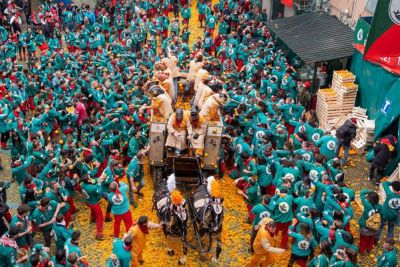Dal 27 febbraio al 3 marzo, accadrà la Battaglia delle Arance al paesino di Ivrea in Piemonte. Questo carnevale cominciò nell’epoca medievale quando la figlia di un mugnaio non si volle sposare con il barone. Lei uccise il barone con una spada. Dopo, cominciò una rivolta contro il barone. Oggi, la battaglia continua come una tradizione. Dopo tre giorni, c’è uno scarlo, adorato con ginepro ed erica, che brucia. Se brucia lento, significa che l’anno prossimo non andrà bene. Invece se brucia veloce, l’anno prossimo sarà prosperoso.
Referred to as the biggest food fight in Europe, the Battle of the Oranges takes over the town of Ivrea, Italy on the three days preceding Lent. While the 2021 Battle of the Oranges was cancelled due to Covid, 2022’s event takes place on February 27 – March 1.
Around 9,000 tons of oranges are cast in a battle between the townsfolk represented by nine teams of orange throwers and tyrannical orange-yielding soldiers in their carts. The Battle of the Oranges is highly regulated and steeped in tradition, as part of the longer Historical Carnival of Ivrea.
Legend has it that Violetta, a beautiful miller’s daughter refused to comply with the local baron’s droit du seigneur (lord’s right), by which he was allowed to sleep with her on her wedding night. Instead, the young maid took matters into her own hands and struck off the head of the nobleman – allegedly the Marquis of Montferrato – with one sweep of her sword.
Violetta’s actions led to a successful people’s revolt against the baron, who had also starved the townsfolk, which is now re-enacted each year in the Battle of the Oranges. The Miller’s daughter and a Napoleonic General are key figures in the annual festival.
By attacking the soldiers positioned by carts around the village, the fearless orange-throwers are deemed to be taking on all forms of tyranny. At the end of the three days of fighting, prizes are given to those who have shone in terms of loyalty, technique and enthusiasm.
Originally, it was not oranges but beans and legumes that were thrown – as these were distributed to the poor by the Ivrean brotherhoods. One of the main elements of the festival is the series of fagiolate rionali or bean feasts. However, by the 19th century the battle had taken on a more chivalric tone with oranges, which were deemed to be an exotic fruit, cast possibly by young maidens to courtiers from their balconies.
By 1854, the orange tokens had taken on a more aggressive tone, with the manifesto of that year prohibiting the throwing of oranges in a vehement manner. The prohibition went unheeded, and in 1947, the first official Battle of the Oranges was waged with the formation of the Asso di Picche, which is still one of the now nine teams of orange throwers.
Violetta, brandishing her bloody sword, stands over a burning scarlo (pole) garnished with juniper and heather bushes. If it burns brightly the following year will be prosperous, but a slow burner portends no good. The festival concludes with the funeral of the Carnival amid much pomp and ceremony.




